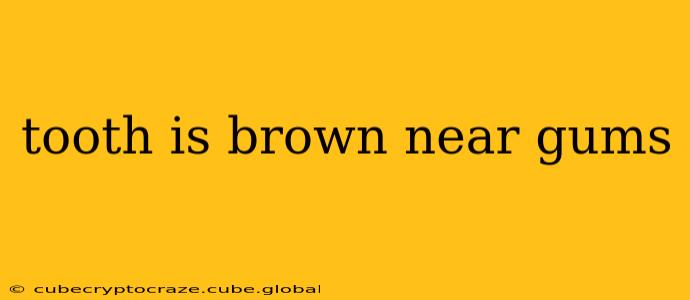Discovering a brown discoloration near your gums can be alarming, but it's important to understand that several factors can contribute to this aesthetic issue. This discoloration isn't always a cause for immediate concern, but it's crucial to identify the underlying cause to address it effectively and prevent potential dental problems. This article will explore various reasons why your tooth might be brown near the gums, offering insights to help you understand and address this concern.
What Causes Brown Teeth Near the Gums?
The brown discoloration near the gum line often stems from issues affecting the enamel, the hard outer layer of your teeth, or the dentin, the underlying layer. Here are some key culprits:
1. Staining: This is often the most common reason. External stains from consuming certain foods and drinks like coffee, tea, red wine, and tobacco can accumulate over time, particularly near the gum line where they're more easily trapped. Certain medications can also contribute to staining.
2. Enamel Erosion: The enamel can wear away, exposing the darker dentin underneath. This can be caused by acidic foods and drinks, aggressive brushing, or even gastroesophageal reflux disease (GERD). The exposed dentin is more susceptible to staining, leading to a brown discoloration.
3. Gum Recession: As gums recede, they expose more of the tooth's root surface. Root surfaces are naturally more porous and yellowish than enamel, appearing darker when exposed, and are more prone to staining.
4. Tetracycline Staining: This type of staining occurs during tooth development if a pregnant mother or a young child (under 8 years old) takes tetracycline antibiotics. It results in a permanent, yellowish-brown discoloration, often concentrated near the gum line.
5. Dental Fluorosis: Excessive fluoride intake during tooth development can lead to dental fluorosis. This condition manifests as white or brown spots or streaks on the teeth, sometimes concentrated near the gum line. The severity varies greatly depending on the amount of fluoride exposure.
6. Decay (Cavities): While not always brown, early-stage cavities can sometimes present as discoloration near the gum line. This discoloration might be brown, black, or even a dark grey. Cavities require prompt professional treatment to prevent further damage.
How Can I Tell What's Causing the Brown Discoloration?
Identifying the root cause requires a professional dental examination. Your dentist can perform a thorough evaluation, including X-rays if necessary, to determine the exact cause of the discoloration. This is essential because treatment varies depending on the underlying issue.
Is it just staining or something more serious?
This is a common question, and the answer depends on the specific situation. While staining is a frequent cause, the dentist will need to rule out other potential problems like decay or gum disease. A visual inspection along with potentially taking X-rays will help them determine this.
What are the treatment options for brown teeth near the gums?
Treatment will vary depending on the cause:
- For staining: Professional cleaning, teeth whitening treatments, or cosmetic bonding might be recommended.
- For enamel erosion: Your dentist may advise dietary changes, modifications to brushing techniques, or the use of fluoride treatments.
- For gum recession: Treatment focuses on managing gum health and preventing further recession. This may involve periodontal therapy.
- For tetracycline staining or dental fluorosis: Cosmetic treatments like bonding, veneers, or crowns might be considered to improve the appearance of affected teeth.
- For cavities: The dentist will need to remove the decayed portion of the tooth and restore it with a filling or other restorative treatment.
How can I prevent brown teeth near the gums in the future?
Prevention plays a crucial role in maintaining healthy teeth and gums. Practicing good oral hygiene is essential:
- Brush your teeth twice a day with fluoride toothpaste.
- Floss daily to remove food particles and plaque from between your teeth.
- Limit consumption of staining foods and beverages.
- Visit your dentist regularly for professional cleanings and check-ups.
By understanding the various factors contributing to brown discoloration near the gums and seeking professional dental care, you can effectively address this issue and maintain a healthy, beautiful smile. Remember, early detection and treatment are key to preventing more significant dental problems.
